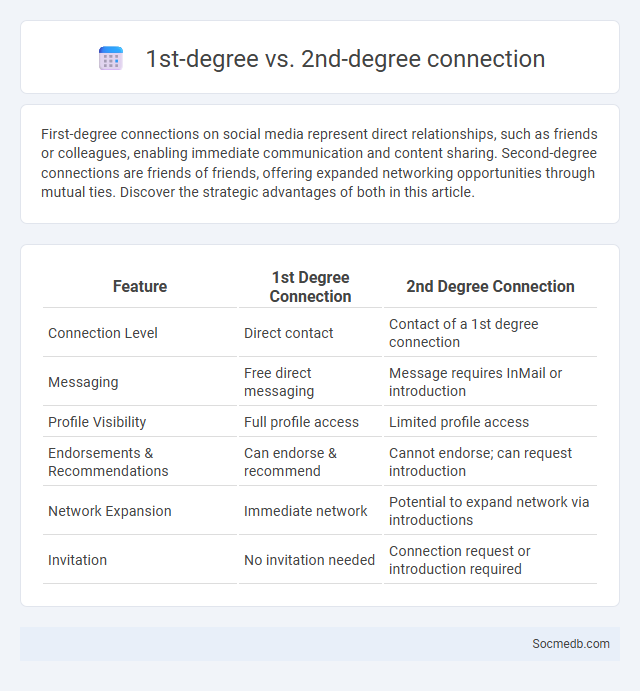
Photo illustration: 1st degree vs 2nd degree connection
First-degree connections on social media represent direct relationships, such as friends or colleagues, enabling immediate communication and content sharing. Second-degree connections are friends of friends, offering expanded networking opportunities through mutual ties. Discover the strategic advantages of both in this article.
Table of Comparison
| Feature | 1st Degree Connection | 2nd Degree Connection |
|---|---|---|
| Connection Level | Direct contact | Contact of a 1st degree connection |
| Messaging | Free direct messaging | Message requires InMail or introduction |
| Profile Visibility | Full profile access | Limited profile access |
| Endorsements & Recommendations | Can endorse & recommend | Cannot endorse; can request introduction |
| Network Expansion | Immediate network | Potential to expand network via introductions |
| Invitation | No invitation needed | Connection request or introduction required |
Understanding LinkedIn Connections: An Overview
LinkedIn connections represent professional relationships that can enhance career growth, networking opportunities, and knowledge sharing within specific industries. Users can categorize connections as 1st, 2nd, or 3rd degree, which indicates their proximity in the network and potential reach for introductions. Leveraging LinkedIn connections effectively requires strategic engagement through personalized messages, endorsements, and content sharing to build trust and establish professional credibility.
What is a 1st Degree Connection?
A 1st Degree Connection on social media platforms like LinkedIn represents a direct connection between two users who have mutually accepted each other's connection requests. This level of connection allows for easy communication, profile viewing, and content sharing without restrictions. Understanding 1st Degree Connections helps users expand their professional network efficiently by leveraging immediate contacts.
Defining 2nd Degree Connections
Second-degree connections on social media are users who are connected to your direct contacts but not connected to you personally, expanding your network beyond immediate friends or followers. These connections enable broader networking opportunities and increase the reach of your content by tapping into friends-of-friends or mutual contacts. Platforms like LinkedIn leverage second-degree connections to facilitate introductions and potential collaborations within extended professional circles.
General Connections: Beyond 1st and 2nd Degree
Social media platforms facilitate General Connections that extend beyond 1st and 2nd degree networks, enabling users to reach vast, untapped audiences through shared interests and mutual contacts. Algorithms leverage graph theory to recommend 3rd degree or higher connections, enhancing social capital and expanding influence across diverse communities. This extended networking potential drives engagement, professional opportunities, and information dissemination on platforms like LinkedIn, Facebook, and Twitter.
Key Differences Between 1st and 2nd Degree Connections
1st-degree connections on social media are direct contacts with whom You share a connection, allowing instant communication and access to their shared content. 2nd-degree connections are contacts of Your 1st-degree connections, offering an extended network but requiring an introduction or request to connect. Understanding the differences helps optimize networking strategies and enhances targeted outreach effectively.
How to Leverage 1st Degree Connections
Leverage your 1st degree connections on social media by actively engaging with their content to increase visibility and foster stronger relationships. Utilize personalized messages to initiate meaningful conversations that can lead to collaboration or business opportunities. Your direct network serves as a valuable resource for referrals, endorsements, and expanding your influence within targeted communities.
Expanding Your Network Through 2nd Degree Connections
Leveraging 2nd degree connections on social media platforms such as LinkedIn significantly enhances networking opportunities by bridging gaps between direct contacts and their extended networks. Engaging with content shared by these connections and strategically participating in group discussions improves visibility and fosters trust among potential collaborators or clients. Utilizing advanced search filters to identify 2nd degree contacts aligned with industry goals maximizes the efficiency of expanding professional relationships.
Benefits of Each Connection Type for Networking
Social media platforms offer unique benefits for networking through different connection types: strong ties like close friends provide trusted support and deep collaboration opportunities, while weak ties such as acquaintances expand your reach and introduce diverse perspectives. Bridging ties link you to new networks and industries, increasing access to valuable information and job opportunities, whereas bonding ties strengthen relationships within your immediate community, fostering loyalty and sustained engagement. Harnessing these varied connections efficiently enhances your professional growth and opens doors to innovative collaborations.
Strategies to Convert 2nd Degree to 1st Degree Connections
Leveraging personalized engagement and targeted content can effectively convert 2nd-degree connections into 1st-degree relationships on social media platforms. You should focus on meaningful interactions such as commenting on their posts, sharing relevant content, and sending tailored connection requests that highlight mutual interests or benefits. Utilizing LinkedIn's advanced search filters or Facebook's friend suggestions can streamline finding valuable contacts to expand your professional network.
Maximizing Opportunities: Building Meaningful Connections
Maximizing opportunities on social media involves strategically engaging with your audience to build meaningful connections that foster trust and loyalty. Consistently sharing valuable content tailored to your followers' interests enhances interaction and encourages genuine communication. By actively listening and responding, you strengthen relationships that can lead to new collaborations, business growth, and increased brand visibility.
 socmedb.com
socmedb.com